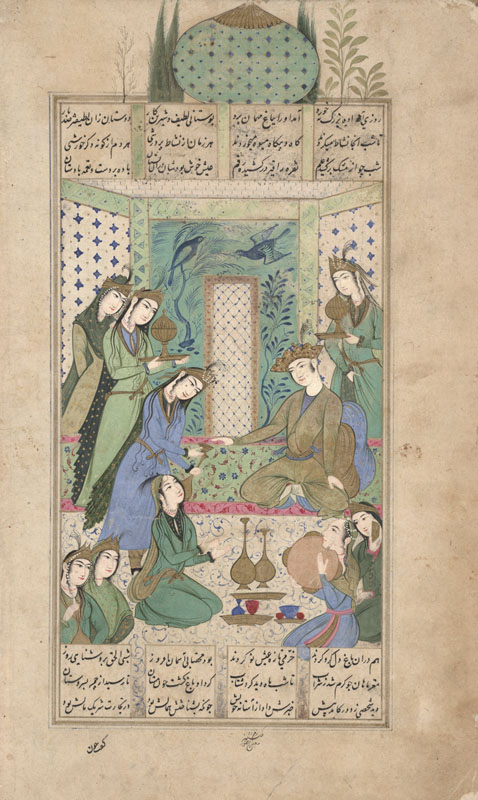Bahrām Gur Entertained by the Princess in the Green Pavilion
Bahrām made it a practice to visit one pavilion a day, in order, from the first day to the last. The third pavilion, Monday’s, was green. The painting is nearly monochromatic, being executed in several shades and tones of green, with only touches of blue brown and red. Bahrām Gur is seated on the right, leaning on two pillows. He wears a long robe knotted at the waist with a sash, and on his head is a jewelled crown with a feather. The Tartar princess of the green pavilion is seated opposite him in the left foreground, with both arms extended in a gesture. She wears a long dress, and a cape or chador that extends from the back of her head, down the length of her back, and then curls on her lap. Eight other females are portrayed in the scene, all similarly clad in long dresses with a sash, long strands of black hair that hang well beyond their shoulders, and tiaras sometimes decorated with pearls. All are obviously maidservants in various pursuits -- most hold trays or vessels of drink, and one, in the right foreground is a musician with a tambourine. The floor is divided into two bands, one behind the other in pictorial depth, both of which are decorated with fine floriated scroll patterns. Several vessels of food and drink are arranged on the floor between the tambourine player and the princess. The backdrop is a painted panel of birds and foliage with a latticed window(?) inset in the center, and flanked on each side by a tiled wall shown in perspective. Above the text the painting continues into the upper margin with a tiled bulbous dome flanked on each side by two cypress trees and other foliage.
Painting dimensions (without extensions): 17.6 x 12.4 cm. Painting with extensions into the upper margin: 24.7 x 12.4 cm. The text is written in four columns, three lines each above and below the painting. A rectangular ruled frame encloses painting and text, except on the top where the bulbous dome, cypress trees, and other vegetation, violate the frame and protrude into the upper margin. The page is signed in the center of the lower margin in Moʿin’s hand: raqam zad kamina moʿin-e moṣavver. The painting is executed in excellent Mo¯in style and an attribution to the master appears in order. No date is recorded, and there is little stylistic evidence to date it with any degree of certainty, but circa 1660 might be considered.
Photo: Used by permission of the Rare Book Department, Free Library of Philadelphia
Location:
The Philadelphia Free Library, #FLP Lewis O P146.
Formerly in the John Fredrick Lewis Collection.
Painting references:
Unpublished
Text references:
Chelkowski, Khamseh_1975, pp.83-88.
Robert Eng
Last Updated: April 18, 2011 | Originally published: April 18, 2011
